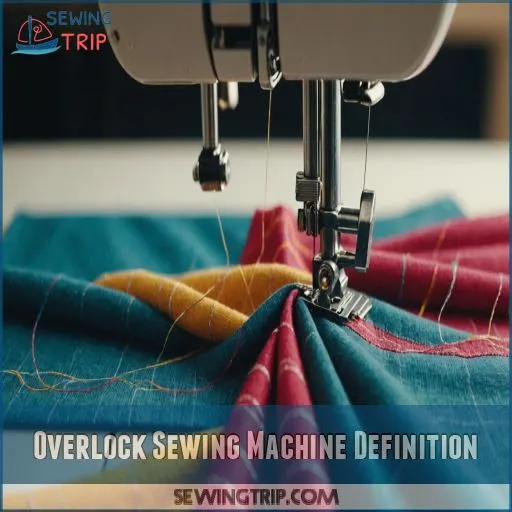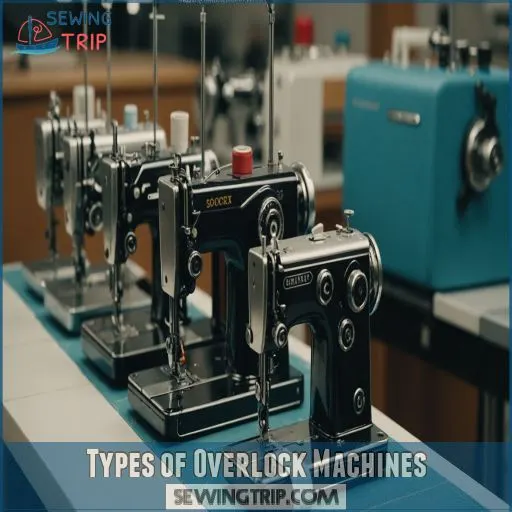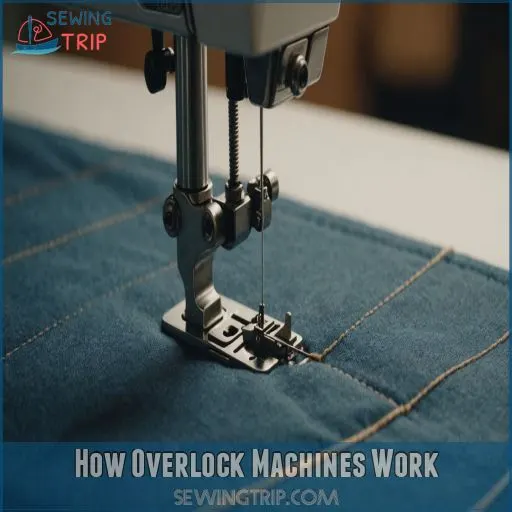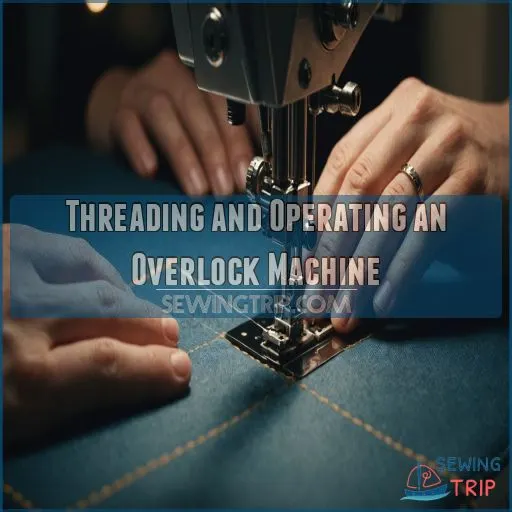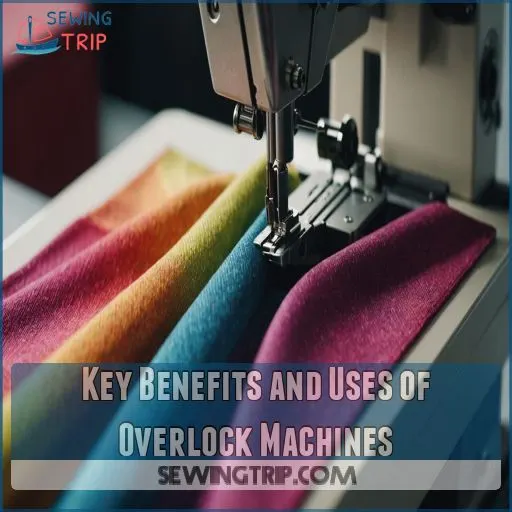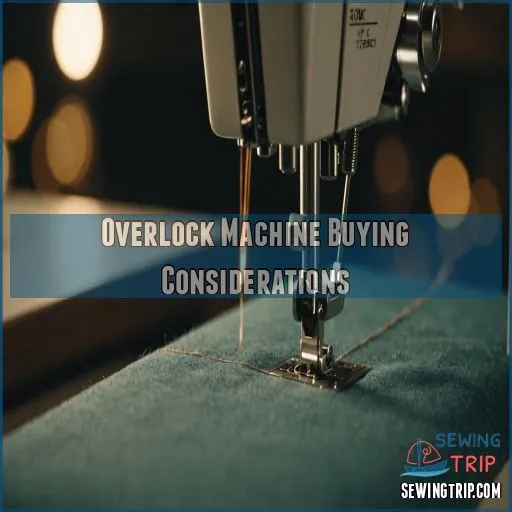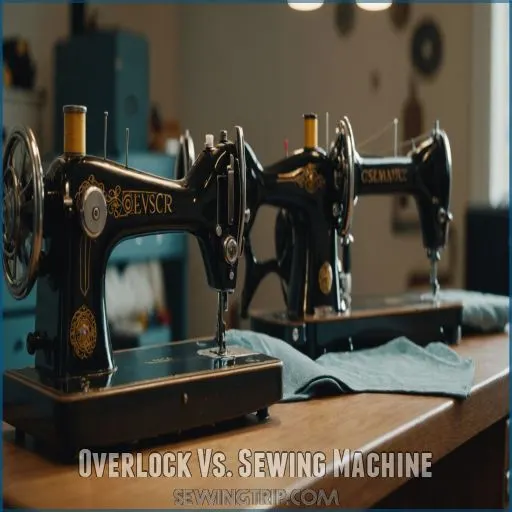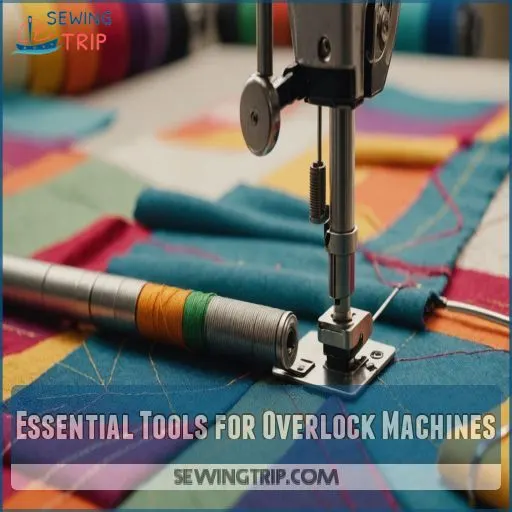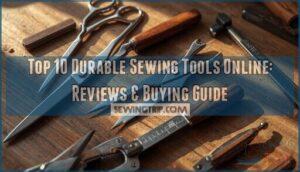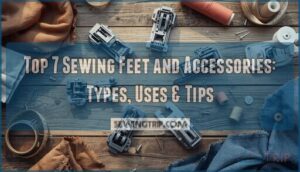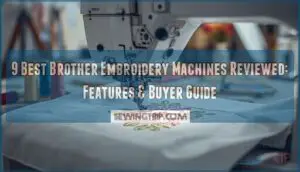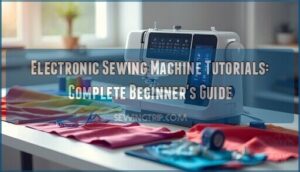This site is supported by our readers. We may earn a commission, at no cost to you, if you purchase through links.
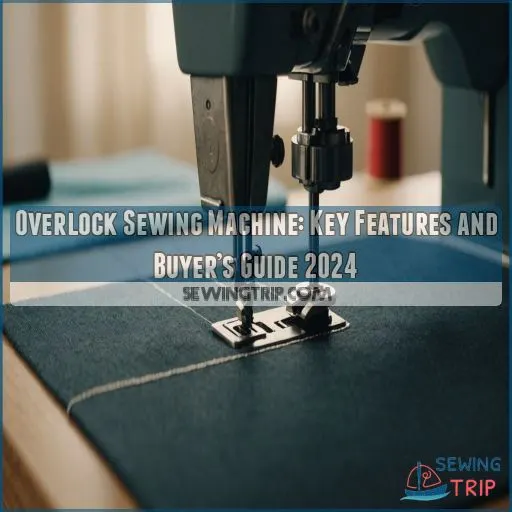
Want to prevent frayed edges and achieve a polished look? An overlock machine does just that, making your seams sturdy and stylish.
Think of it as the multitasking maestro of sewing machines with its multiple threads, built-in blade, and differential feed system.
Whether you’re working with stretchy knits or heavy denim, it handles them all.
Curious how it ups your sewing game? Here’s where it gets even more exciting!
Table Of Contents
- Key Takeaways
- Overlock Sewing Machine Definition
- Distinct Mechanisms and Features
- Types of Overlock Machines
- How Overlock Machines Work
- Threading and Operating an Overlock Machine
- Key Benefits and Uses of Overlock Machines
- Overlock Machine Buying Considerations
- Overlock Vs. Sewing Machine
- Essential Tools for Overlock Machines
- Frequently Asked Questions (FAQs)
- Conclusion
Key Takeaways
- Overlock machines, also known as sergers, are your sewing sidekick that trims, stitches, and neatly encloses fabric edges all in one swift motion—no magic wand required! They’re the multitasking maestros that’ll give your projects a polished, professional look.
- With features like multiple thread options, a differential feed system, and a built-in blade, overlock machines make sewing a breeze. Adjust stitch settings, tackle various fabrics, and watch your creations come to life with a touch of sewing flair.
- Choosing the right overlock machine is like finding the perfect pair of jeans—it depends on your budget, experience level, and sewing goals. Consider thread count, ease of use, and specialty features to find the one that suits you best.
- Overlock machines are the sports cars of the sewing world—they may cost a bit more upfront, but their speed, versatility, and professional results make them a worthwhile investment. Plus, they’ll have your sewing projects looking like they were made by a fashion designer (even if your cat is the only one watching).
Overlock Sewing Machine Definition
Overlock sewing machines, also known as sergers, are your best friends for giving fabric edges a neat, professional finish.
They trim, stitch, and enclose seams all at once, making your sewing projects both sturdy and stylish—no magic wand required!
Explanation of Overlock Machines
An overlock machine, or serger, is your sewing ally for professional seam finishes.
It seams fabric, trims excess, and overcasts raw edges in one swoop.
Consider these perks:
- Speed: Finish projects faster.
- Versatility: Tackle various fabrics.
- Seam Strength: Keep seams snug and secure.
Purpose and Function of Overlock Machines
With your trusty overlock sewing machine, you can conjure up impeccable seam finishes, effortlessly trimming and stitching in one swift motion.
seam finishes and stitching in one swift motion.
Whether tackling various fabric types or experimenting with stitch options like rolled hems and decorative edges, this serger’s built to boost your sewing techniques, offering versatility and efficiency .
Key Benefits of Using Overlock Machines
Ever feel like your sewing projects could use a dash of professionalism?
An overlock sewing machine, frequently called a serger, is your trusty sidekick.
It creates durable, versatile seams, trims edges, and decorates your work efficiently.
Say goodbye to fraying!
Perfect for the sewing enthusiast who values time-saving, polished finishes .
Distinct Mechanisms and Features
When you’re using an overlock sewing machine, you’ll discover its unique mechanisms like multiple thread options, a differential feed system, and a built-in blade for efficient trimming.
These features simplify sewing tasks and add a professional touch to your projects, making you feel like a fashion designer—even if your cat is the only one watching your sewing debut!
Multiple Threads and Stitch Options
Overlock machines offer a variety of thread and stitch options to tackle any sewing project.
With 2-5 threads and an array of overlocked, chainstitch, and decorative stitches, you’ll have the versatility to create strong, professional-looking seams.
Differential Feed System for Fabric Control
If you’ve ever wrestled with wavy seams on knits, the differential feed system on your overlock sewing machine is your secret weapon.
It adjusts fabric feed rates, ensuring seam evenness and preventing puckering.
This ultimately offers precise fabric-stretch control for various thicknesses (Source).
Built-in Blade for Trimming Fabric Edges
Your overlock sewing machine’s built-in blade trims fabric edges neatly while you sew.
Keep an eye on blade sharpness, especially when switching fabric types.
Regular maintenance and timely blade replacement make sure smooth operation, giving you control over every sewing project .
Various Stitch Options for Different Fabrics
An overlock sewing machine offers various stitch options to tackle different fabrics like stretch knits, delicate lace, or robust denim.
Adjusting stitch width and tension, using stitch fingers, lets you create sewing patterns beautifully suited for woven, satin, and more (Source).
Types of Overlock Machines
When choosing an overlock machine, you’ll find options like the 4-thread for general sewing, the 5-thread for added seam strength, and the versatile 2-3-4-thread convertible machine.
Finding the right fit is like picking the perfect pair of jeans—what suits one mightn’t suit another, but getting it right makes all the difference!
4. Thread Overlock Machines for General Sewing
If you’re looking at 4-thread overlock machines, they’re like having an octopus in your sewing room—multitasking with flair!
These machines stitch and trim simultaneously, managing thread tension with ease.
Perfect for various fabric types, sewing basics, and quick sewing projects.
5. Thread Overlock Machines for Added Strength
Switching from a 4-thread to a 5-thread overlock machine adds strength and efficiency to your sewing projects.
This machine handles various fabric types with ease, offering benefits like durable safety stitches and versatile serger stitch types for professional finishes .
2. 3-4-Thread Convertible Overlock Machines for Versatility
2-3-4-thread convertible overlock machines offer unparalleled versatility.
You can tackle a wide range of sewing projects, from delicate fabrics to heavy-duty materials, with the ability to adjust the number of threads.
Plus, the easy threading process and color-coded guides make operation a breeze. (Source)
Choosing the Right Overlock Machine for Your Needs
Choosing the right overlock machine is like finding the perfect pair of scissors; it depends on your budget, experience level, and sewing goals.
Consider fabric types, stitch options, and brand reputation.
With your sewing history, balance speed and finish with flair!
How Overlock Machines Work
Want to give your sewing projects a professional finish?
With an overlock machine, you’ll master threading, adjust stitch settings with precision, and effortlessly feed fabric through.
All while marveling at how it trims and stitches in one swift motion—much like a culinary multitasker that chops, sautés, and plates all at once!
Threading the Overlock Machine
Threading an overlock sewing machine might seem like a labyrinth at first, but with the machine’s color-coded threading diagrams, it’s a breeze.
Adjust tension settings based on thread types, and don’t forget to follow your looper threading sequence methodically for perfect results.
Setting Stitch Type, Width, and Length
Now that you’ve mastered threading, let’s tackle stitch settings!
Adjusting stitch types, width, and length transforms your projects.
Want a perfect rolled hem or plush finish with wooly nylon?
Play with stitch tension and wonder clips for precise control and fabulous seams .
Feeding Fabric Through the Machine Correctly
You’re nearly at the finish line with your overlock setup! To feed fabric properly, pay attention to:
- Fabric Alignment: Make sure it’s straight for even seams.
- Seam Tension: Adjust for fabric type.
- Feed Dog Adjustment: Essential for smooth feeding.
- Fabric Guidance: Steer gently, let the machine work.
Simultaneous Trimming and Stitching for a Clean Finish
Mastering the art of feeding fabric means you can tap into your overlock machine’s superpower: simultaneous trimming and stitching.
It creates a clean finish by cutting away frayed edges while sewing, offering efficient, professional results on various fabric types .
Threading and Operating an Overlock Machine
Threading an overlock machine can seem tricky, but BERNINA makes it easy with their color-coded threading schematics.
Once you’ve threaded it up, simply test the machine by stitching in the air to make sure you’ve got a complete chain – no more guesswork!
Color-Coded Threading Schematics for Easy Reference
Threading diagrams make life easier, especially for beginners. Here’s why color-coded schematics are your best friend:
- Quick Threading: Say goodbye to frustration.
- Error Reduction: Mistakes, schmistakes!
- Ease of Learning: It’s like threading training wheels.
- Visual Clarity: See it, thread it, love it.
Embrace the colorful guide to freedom!
Testing the Machine for Proper Stitch Formation
After mastering color-coded threading, it’s time to make sure proper stitch formation is happening.
Refer to the table below for tips on testing your overlock machine:
| Aspect | Checkpoint |
|---|---|
| Stitch-chain check | Smooth consistency |
| Needle timing | Synced needles |
| Tension adjustment | Balanced stitches |
| Thread consistency | Even feed |
| Loopers alignment | Proper crossover |
Run a stitch-chain check for perfect seams!
Adjusting the Differential Feed for Fabric Thickness
Once you’ve tested your machine’s stitch formation, it’s time to adjust the differential feed for fabric thickness.
This helps achieve an even feed, avoiding fabric stretch or puckering.
- Increase for knit fabrics.
- Decrease for woven fabrics.
- Experiment with scraps.
- Listen to the machine’s hum.
- Find your fabric’s sweet spot .
Key Benefits and Uses of Overlock Machines
When you’re ready to kick your sewing projects up a notch, overlock machines are your trusty sidekicks, always ready to prevent fabric fraying and deliver professional seams in no time.
These versatile workhorses handle everything from stretchy knits to silky fabrics, making sewing more efficient and letting you showcase your creative flair with decorative finishes.
Preventing Fraying and Raveling of Fabric Edges
An overlock sewing machine keeps fabric edges tidy, preventing unraveling with precise stitch tension and serger blade action.
It’s your trusty fabric guardian, tackling various types—woven, knit, or delicate—with ease, ensuring smooth hemming techniques every time.
| Feature | Benefit |
|---|---|
| Multiple Threads | Stronger Seams |
| Differential Feed | Smooth Fabric Flow |
| Adjustable Tension | Customizable Stitches |
| Built-in Blade | Clean Edge Trimming |
| Versatile Stitching | Adaptable Fabric Care |
Creating Neat, Professional Seam Finishes
For neat, professional seam finishes, overlock machines are your secret weapon.
They create clean edges with:
- Overlock stitch types
- Perfectly trimmed seams
- Fewer frayed edges
- Consistency in stitching
Master these for stunning sewing results!
Versatility for Multiple Fabric Types and Thicknesses
Your overlock machine’s versatility lets you tackle a wide range of fabrics, from delicate knits to sturdy wovens, with precision and ease.
Speeding Up Sewing Time With Simultaneous Trimming and Stitching
Switching from versatility to speed, overlock machines save time by trimming and stitching simultaneously.
You’ll appreciate:
- Quick seam finishes
- Less fabric handling
- Efficient project workflow
- Reduced thread bulk
- Enhanced stitch speed .
Creating Decorative Edges and Finishes
Overlock machines jazz up fabrics with decorative stitches like a maestro orchestrating lively patterns, making every project sing.
While you’re busy zipping through seams, don’t forget the magic of lettuce edges and rolled hems!
| Edge Type | Stitch Pattern | Fabric Finish |
|---|---|---|
| Lettuce Edges | Curved Ripple | Stretch Fabrics |
| Rolled Hems | Tight Rolls | Delicate Silks |
| Decorative Stitches | Intricate Designs | All Fabrics |
Overlock Machine Buying Considerations
When you’re in the market for an overlock machine, you need to think about factors like the number of threads and stitch options, ease of use, and your budget.
Don’t let the array of features overwhelm you—focus on what meets your sewing needs, and remember, even the fanciest machine won’t thread itself or bring you coffee in the morning!
Number of Threads and Stitch Options
Exploring overlock machines’ number of threads and stitch options can lead to your sewing glory!
Jumping from key benefits, here’s the scoop:
- Four-thread: Basic seam finish.
- Five-thread: Extra strength.
- Three-thread: Light stitches.
- Two-thread: Minimal use.
Ease of Use and Threading Difficulty
You’ve mastered stitch options, now imagine threading an overlock machine: it’s like wrestling a mischievous octopus.
Threading tips, such as tackling looper challenges, simplify first-time use.
Avoid common mistakes and make sure you can smoothly troubleshoot any problems.
Specialty Features and Budget
After tackling threading woes, let’s chat about advanced features fitting your budget.
Think about:
- Varying thread counts
- Differential feed versatility
- Integrated rolled hemming
- Price-friendly options .
Find features without blowing your budget!
Quality of the Built-in Blade and Differential Feed
The built-in blade’s sharpness and differential feed’s precision are really important for clean, consistent stitches across diverse fabrics.
Proper maintenance helps your overlock machine run its best and extends its lifespan.
| Blade Sharpness | Differential Feed |
|---|---|
| Impacts edge trimming and fabric control | Adjusts feed rate for even, wrinkle-free results |
| Requires periodic sharpening for best cuts | Makes sure proper fabric tension and handling |
| Dull blades can snag or tear delicate fabrics | Really important for sewing stretchy, slippery, or bulky materials |
Brand Reputation and Customer Support
Choosing an overlock machine? Considering brand reputation and customer support is really important.
Imagine stepping into this new world with confidence by focusing on:
- Warranty coverage
- Repair services
- Online reviews
- Friendly, reliable customer assistance.
Overlock Vs. Sewing Machine
If you’ve ever wondered why your sewing projects aren’t quite hitting that professional mark, it might be time to think about an overlock machine.
It’s like switching from a bicycle to a sports car—suddenly, your seams are smooth, your fabric edges are tidy, and sewing becomes a whole new speed-driven adventure!
Purpose and End Result of Each Machine
Wrapping up your sewing project with finesse often hinges on your machine choice.
Here’s a quick comparison:
| Feature | Overlock Machine | Regular Sewing Machine |
|---|---|---|
| Seam Finishing | Professional, Fray-Free | Basic, May Fray |
| Fabric Types | Knits, Stretch Fabrics | Wovens, Varied Fabrics |
| Stitch Quality | Strong, Durable | Versatile, Decorative |
| Time Savings | High, Simultaneous Tasks | Moderate, Sequential |
Choosing the right tool gives you sewing freedom and joy!
Stitch Types and Seam Finishing Abilities
For stitching, overlock machines excel by providing a range of stitch types like the overlock stitch, rolled hems, and flatlock seams.
They’re like multitasking ninjas, offering professional finishes and durability compared to traditional sewing machine stitches .
Cost and Investment Comparison
When deciding between an overlock sewing machine and a regular sewing machine, consider your budget and value-for-money.
Overlock machines, often pricier upfront, offer excellent long-term return on investment, longevity, and resale value, especially for those needing professional seam finishes .
Space and Portability Considerations
Finding room for your sewing gear? Overlock machines often need more storage space due to their extra features like built-in blades.
But compact models are available.
Consider table size, machine weight, and if a travel case is included for easy portability .
Essential Tools for Overlock Machines
Maintaining your overlock machine is a breeze with the right tools.
From specialized overlocker oil to handy Wonder Clips, these essentials will keep your serger running smoothly and your seams looking professional.
Overlocker Oil and Thread Nets
You’ll want to keep your overlocker in top shape with proper care and tools. Here’s a quick guide:
- Oil Types: Use sewing machine oil to lubricate parts.
- Thread Net Benefits: Prevents unraveling.
- Cleaning Routine: Regularly remove lint.
- Storage Tips: Keep in a dust-free place.
Awl or Stiletto for Feeding Fabric
While overlocker oil keeps your machine running smoothly, an awl or stiletto is your trusty sidekick for fabric feeding.
Like a crafty wizard, it guides the material precisely where you want it, ensuring neat finishes and reducing fabric bunching.
Wonder Clips by Clover for Holding Fabric
Ever wondered how to avoid fabric slippage during your overlock projects?
Wonder Clips by Clover are your fabric’s best friend!
Unlike overlocker pins, they don’t risk bending or damaging needles, keeping tension adroitly managed.
Safety first with these handy Clover products!
Tapestry Needles for Securing Thread Chains
Tapestry needles are your trusty companions for securing thread chains in seam finishing.
They easily weave through stitches, ensuring your seams stay intact.
- Large eye accommodates overlock threads
- Simplifies chain securing
- Enhances overlock techniques
- Prevents thread unraveling
Frequently Asked Questions (FAQs)
What is an overlocker sewing machine?
An overlocker, or serger, is a specialized sewing machine that trims fabric edges, stitches them, and wraps thread around them to create a professional-looking, durable seam.
Perfect for sewing knits, wovens, and more.
What is an overlock machine used for?
Imagine a dance of threads that sews seams, trims edges, and prevents fraying all at once.
An overlock machine is your partner in creating smooth hems, durable seams, and decorative trims with speed and efficiency .
Can you use a serger / overlocker with a sewing machine?
Absolutely, you can use a serger with a sewing machine!
While the serger finishes raw edges with precision, your sewing machine handles detailed stitches.
Together, they create professional-quality seams and edges, enhancing your sewing projects beautifully.
What is a hobbylock overlocker sewing machine?
With speeds up to 1,500 stitches per minute, the Hobbylock overlocker makes sewing a breeze.
It combines traditional serger functions with user-friendly features, perfect for achieving professional finishes on projects ranging from T-shirts to chiffon dresses .
What is the difference between a sewing machine and an overlocker?
You’ll find that an overlocker sews, trims, and finishes fabric edges simultaneously with multiple threads.
Sewing machines, on the other hand, focus on stitching with one or two threads.
This makes them great partners for versatile sewing projects .
Can I use overlock machine for regular sewing?
An overlock machine can’t replace a standard sewing machine for regular sewing.
It specializes in finishing edges and seams but lacks capabilities like buttonholes or topstitching, which are bread and butter for a regular sewing machine.
What is the purpose of overlocking sewing?
Imagine a tailor’s magic wand—overlocking sewing gives your fabrics a polished look, preventing fraying by trimming edges and encasing them in neat stitches.
It’s the secret weapon for professional seams and durable garments .
What is the difference between a cover stitch machine and an overlocker?
The key difference between a cover stitch machine and an overlocker is their purpose – an overlocker trims and finishes seams, while a cover stitch machine creates professional-looking hems and decorative stitches, particularly on stretchy fabrics.
How do sergers handle curved seams?
Sergers manage curved seams by lining up fabric edges with the blade and using gentle rotations.
For outer curves, rotate right; for inner curves, go left.
Practice keeps puckering at bay—patience and precision are critical .
What table setup is ideal for a serger?
Picture a serger workstation where comfort meets function.
Opt for a sturdy, adjustable-height table to create an ergonomic setup.
An Ikea or standing desk lets you tailor the height, reducing strain and boosting smooth sewing sessions .
How to prevent fraying without a serger?
Use a zigzag stitch or overcast stitch on your sewing machine to prevent fabric fraying without a serger.
Attach an overcast foot if possible for cleaner seams.
French seams are also great for fully encasing raw edges .
Can sergers replace regular sewing machines completely?
While sergers create beautifully polished edges at lightning speed, they can’t completely replace regular sewing machines.
Regular machines offer versatility with multiple stitches for hems, buttonholes, and intricate designs, which sergers just can’t match .
Tips for maintaining sharp corners with sergers?
To maintain sharp corners with a serger, slow your stitching as you approach the edge.
Stop precisely at the corner.
Pivot the fabric and continue.
Practicing these moves leads to crisp, clean edges .
Conclusion
Surprisingly, mastering an overlock sewing machine isn’t just about having the right tool—it’s a game-changer for your sewing projects!
With its multitasking abilities, an overlock machine trims, sews, and finishes seams in one go, providing a polished and professional finish .
Whether you’re a novice or a seasoned sewist, investing in this versatile tool will elevate your craft, ensuring your creations are both stylish and durable .
Embrace the magic of what an overlock sewing machine can offer!

